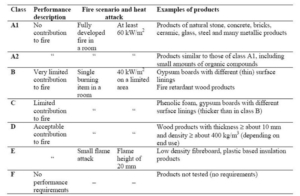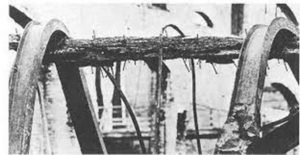What is the difference between reaction and resistance to fire? Firestopping FAQs
Many people might not be aware that there are different fire testing methods. When it comes to buildings and how they will perform in a fire, the methods used are known as ‘reaction to fire’ and ‘fire resistance.’ These two methods cover different aspects relating to the stages of fire development, and understanding these differences is vital.
Reaction to fire:
This refers to how a material behaves when it is exposed to fire. It involves assessing how quickly a material ignites, how fast the flames spread over its surface, and the amount of heat, smoke, and flaming droplets it produces. Ultimately, it focusses on the material’s immediate response to the fire and the extent to which it is combustible, contributing to the growth of a fire to a stage where the ‘flashover’ occurs. Flashover means the sudden spread of flame over an area when it becomes heated to the flash point.
The testing procedures and standards for measuring reaction to fire may vary depending on the country or region. Standardised tests, such as the European standard EN 13501-1, are often used to determine the reaction to fire classification of construction materials.
There are seven groups, from A1 to F, where A1 is non-combustible and F is combustible. The groups are A1, A2, B, C, D, E, and F:

2. Classes and criteria. Retrieved from http://virtual.vtt.fi/virtual/innofirewood/stateoftheart/database/euroclass/euroclass.html
This standard also references smoke and flaming droplets:
Smoke Opacity (S)
S1: Little smoke.
S2: Medium amount of smoke.
S3: Vast amount of smoke.
Flaming Droplets/Particles (D)
D0: Produces drops or particles.
D1: Produces drops and/or non-burning particles.
D2: Produces drops and/or burning particles.
Resistance to fire:
This refers to a material’s ability to withstand fire without becoming too damaged or contributing to the fire. Resistance to fire involves evaluating how well a material can endure the effects of a fire, including high temperatures and flames, among other fire-related aspects.
The fire resistance of a building can be broken down into three primary classifications:
- Loadbearing capacity
- Integrity
- Insulation
Loadbearing capacity:
This is the building support system’s ability to remain intact and fulfil its intended function without collapsing. For instance, concrete may suffer ‘spalling,’ which is the breaking away of pieces of concrete frame when exposed to fire. Prolonged exposure to severe fire may lead to a significant loss of strength from eroded concrete.
Integrity:
Integrity (E) highlights the time that the component can withstand and prevent fire and smoke from breaching the compartmentation of the building.
Insulation:
Insulation (I) is a measurement of time indicating how long a component can withstand the heat generated from a fire and prevent it from breaching the building’s compartmentation. During the fire, the construction on the non-heated side typically should not increase in temperature above an average of 140°C or by more than 180°C at any point.
Why is it important to understand the difference?
A material’s overall performance may be different when subjected to reaction to fire and fire resistance testing. It is important that when choosing your product or application, you review the correct fire test evidence to meet your scenario requirements.
For example, steel beams are classed as A1 under reaction to fire testing methods. However, from a fire resistance perspective, it loses half its strength at around 500°C. An unprotected steel structure with an A1 rating might collapse if loaded to its full design capacity and exposed to temperatures exceeding 500°C. Such temperatures are likely to occur relatively quickly in the build-up of a fire, meaning it would fail the loadbearing requirement.
This widely shared picture below depicts a timber beam supporting unprotected steel beams after being exposed to a fire. It showcases that just because something is non-combustible does not automatically mean it is suitable for the application:

This is also very true when considering services in a building; large metal pipes or cable carriers are excellent conductors of heat, so careful consideration and protection are necessary for these service types to ensure the insulation requirement is met.
Read also: Should non-combustible metal pipes with a diameter of below 160mm be firestopped?
To conclude, a material’s reaction to fire reflects how much it contributes to fire growth within a building. Meanwhile, fire resistance is a construction element’s ability, like a wall or door, to withstand the fire’s spread, extending beyond the room of origin.
For any further questions, please don’t hesitate to contact us at technical@quelfire.co.uk.

